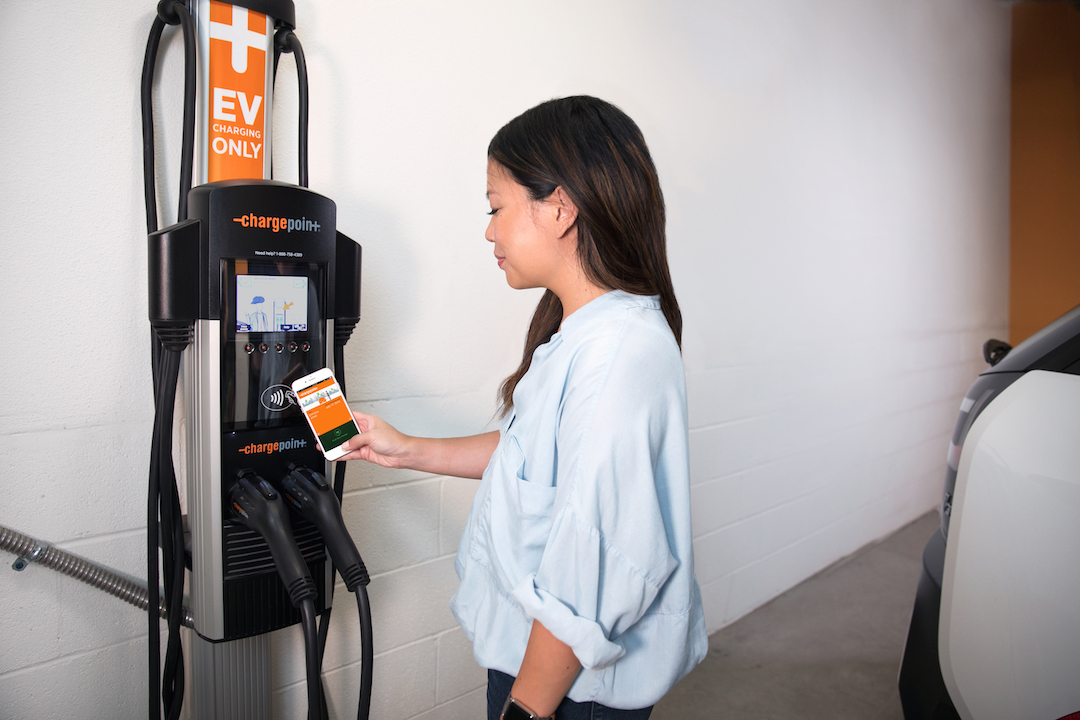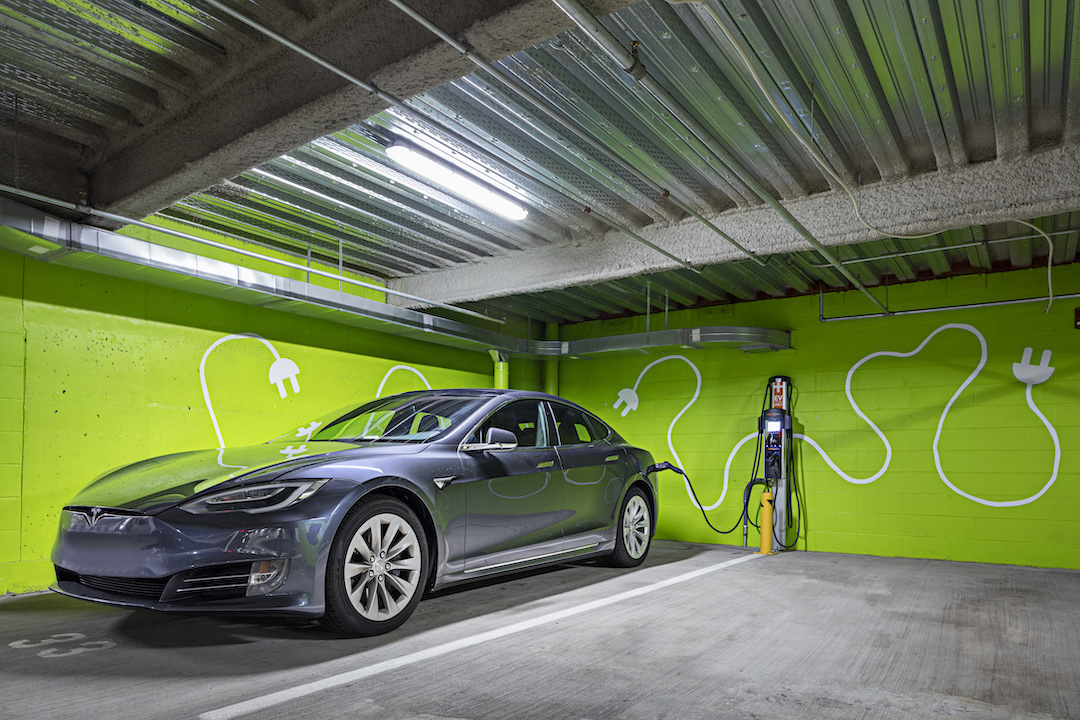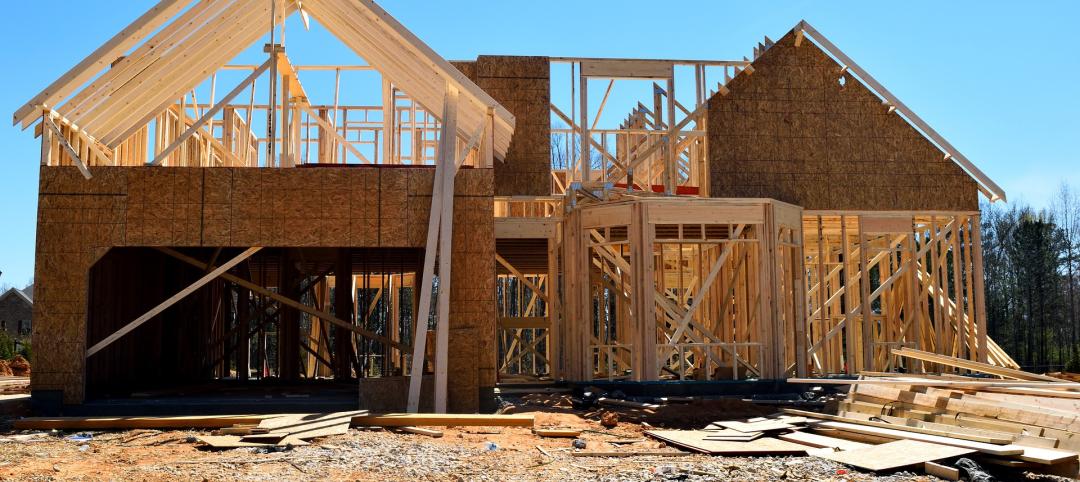Electric vehicle adoption is expected to grow at a 25% annual clip over next five years. That’s going to make the installation of electric charging stations a must at apartment communities in most major real estate markets. Having EV stations on your property can lift its value, help you retain residents, and give your marketers another plus to attract prospective renters in competitive multifamily markets.
For advice on how best to install EV charging stations in multifamily enterprises, we turned to Pete Zadoretzky, LEED AP O+M, Vice President – Sustainability, Bozzuto Management Company. The company owns and manages more than 250 apartment communities, about two-thirds of which have EV stations. Bozzuto recently was named Energy Star’s Partner of the Year–Energy Management for the fourth year in a row—the only 100% multifamily management company to do so.
THE TIME IS RIGHT FOR EV CHARGING PORTS IN MULTIFAMILY HOUSING
1. Start thinking now about EV charging stations.
Nearly half of respondents (48.6%) to our exclusive Multifamily Design+Construction “Amenities Survey 2019” said they had installed EV chargers in multifamily projects, up from 42.0% in our 2017 survey. That means most multifamily developers and their project teams have yet to install EV charging stations.
“It used to be, developers would ask, How much? And when they saw the price, it was, Thanks, but no thanks,” said Zadoretzky, a Fitwell Ambassador. (A 2016 study in San Francisco found that the cost of installing 12 PV ports in a 60-space parking lot was about $860/port, $2,370/port for a retrofit.) According to Zadoretzky, sticker shock has all but evaporated as the cost to install and operate EV stations keeps coming down.
2. Do your homework early in the planning process.
Apartment owners and investors must take the pulse of local market EV demand. Zadoretzky said his company’s preferred charging-station provider, ChargePoint, helps him track the number of EV vehicle registrations at a given time in a given market. “You’ll find a big difference between the number of EVs in, say, suburban Pennsylvania compared to Northern Virginia,” where it’s much higher, he said.
3. Determine the right number of EV charging ports for your property.
“For new construction, it’s important to be thinking strategically about what makes sense when the property first opens and what, when, and how you will be able to increase your capabilities at that property as it matures,” Zadoretzky said.
There was a time when two ports were enough, he said. “Now, we have apartment communities delivering with dozens of stations,” said Zadoretzky. “You don’t want to lose a single lease because there aren’t enough charging stations.”
There’s no perfect yardstick, but the “Guide to EV-Ready Communities” suggests that about 10% of all parking spaces in multifamily housing complexes should be dedicated to charging electric vehicles.
4. Check out the plentiful equipment and supplier options.
“Plug in America,” a resource site for all things EV, lists more than 50 manufacturers and installers; Energy Star profiles about 20. Blink Charging, ChargePoint, and SemaConnect are the best-known full-service providers for multifamily and mixed-use communities. Electrify America, EVGo, and Volta Charging are more common for the retail-facing side of mixed-use communities. Tesla has its own proprietary stations.
Do your homework, advised Zadoretzky. “Looking back on Bozzuto’s history with EV stations, we learned the hard way that not all equipment is created equal,” he said. “You get what you pay for.”

Electric vehicle charging station in an apartment complex: just tap to start the charging process. Photo: Courtesy ChargePoint
Zadoretzky said his company chose ChargePoint because it offered an open platform, fully integrated with Bozzuto’s property management software. The ports’ LCD screens and messaging functions are user friendly.
The stations are open to the public. EV drivers can locate a charging station by searching and getting alerts via the ChargePoint EV app or the PlugShare app, which lists more than 140,000 charging stations in the U.S. and Canada. Retail guests patronizing the mixed-use complex’s restaurants and stores can charge their EVs while they dine and shop; they pay via the ChargePoint app. “Apartment management companies love having cars visiting the property because it brings prospective residents onto the property,” said Zadoretzky.
A second option—at roughly one-third the price—provides an assigned space, one port per customer for the term of the lease, as long as the lessee has an electric vehicle. “It’s a stripped-down version,” Zadoretzky said. “It’s more efficient, but only one car can use it.”
DEVELOP YOUR SCOPE OF WORK FOR EV CHARGING PORTS
5. Dig into the physical demands of installing EV charging stations.
Initial costs should be baked into your project’s electrical contracting scope of work and budget. A lot of questions have to be answered, said Zadoretzky: How close will the EV spaces be to the electrical room? Will you have to run a lot of conduit? Will you need to expand the size of the nearest electrical panel from original design loads? If it’s a retrofit in, say, a garden apartment community, how much trenching needs to be done to lay the conduit? How deep will you have to dig? Will you have to dig through established landscaping? Through asphalt? If you’re installing the EV stations in a structured parking garage, will the installers need to x-ray the concrete?
As for the cost of installing EV chargers in existing apartment properties, Zadoretzky offered these crystal clear guidelines: “You can analyze numbers all you want, but we know for sure that it can cost three times or even five times more to build EV ports on an existing property compared to new development.”
6. Determine your operating costs.
“There’s no blanket answer to operating costs,” Zadoretzky said. Among the many variables to consider: Will the EV stations be installed in a mixed-use project or a 100% residential one? Is parking assigned to the residents, or is the lot first come, first served? Is there a monthly parking fee for an assigned space? Is there a shortage of parking spaces in the complex? Will parking spaces have to be removed to make way for the ports’ electrical equipment? Will the EV chargers be located on the property or in an adjacent area?
Zadoretzky described a property Bozzuto manages in Boston. Its six ports consumed 19MWh over a 12-month period, at a rate of $0.135/kWh. “That’s about $2,550 for the year, or about $425/port,” he said. “A lot for a building amenity for sure, but a drop in the bucket of the overall building’s energy use—and a non-issue in most cases, as we are recouping the cost of electricity directly from our EV-charging residents.”
7. Look for financial subsidies and incentives.
Government subsidies at the federal, state, and local level can significantly reduce first costs.
“You need to check out any state subsidy programs and combine those with incentives from utility companies for real savings,” Zadoretzky said. “The subsidies vary from state to state, and they are constantly changing. Right now, Massachusetts has one of the best around—not quite 100%, but pretty close. Maryland has excellent state and utility incentives.” Zadoretzky said he’s been surprised that some cities, like Washington, D.C., and whole states (Florida, for example) offer no incentives at all.
According to RCLCO’s 2020 EV Charging Report, commercial incentives can be significant, often covering 50–100% of an EV charger’s hardware, make-ready, ongoing service costs, and station/infrastructure installation. For example, Colorado provides rebates to multifamily property owners for up to 80% of charging station cost. Hawaii will subsidize 100% of the cost of installation.
A 2018 industry survey by CleanTechnica revealed that about 16% of charging station installations obtained government subsidies totaling more than $1,000 per connector, while another 20% received benefits of less than $1,000 per port. But in California, various jurisdictions offer incentives ranging from $3,000 per port to as high as $10,000 for ports in affordable housing communities. A Colorado program offers $9,000 per port for Level 2 smart chargers. Check cleantechnica.com for state-by-state data.
8. Think ahead about the day-to-day management of EV charging stations.
Zadoretzky said Bozzuto’s EV partner, ChargePoint, provides a customer-facing app and a management-facing dashboard that produce real-time information for both property staff and residents. If, for example, a tenant has been using the charger for too long, the dashboard will alert the property manager, who can then ask the tenant to unplug and move the car. Or, the property manager could program the dashboard not to charge a new tenant for a stipulated period as part of the lease signing.
ChargePoint has a Wi-Fi–enabled solution that provides real-time diagnostic data to property management staff. It also tracks and reports carbon emissions data, which is crucial when sharing information with investors or in complying with mandated benchmarking ordinances, said Zadoretzky.
“They’re monitoring our stations 24/7/365. If something goes wrong, their team is there to support us, right away, he said. “That’s crucial.” Usually it’s just a matter of a FaceTime phone call between ChargePoint and a Bozzuto maintenance technician to fix the problem using the display screen on the port.
9. Don’t forget to play the sustainability card.
Properties can earn points toward LEED certification by providing charging stations to serve at least 2% of parking spaces. To qualify for LEED points, EV charging spots must be Level 2 or higher, connected to a network, capable of supporting demand response or time-of-use charging, and compatible with universal EV charging connectors.
10. Beef up your EV marketing and signage.
Zadoretzky said his company made a strategic decision that EV charging stations would be an extension of the apartment community’s brand, and that they must match the customer service levels residents expect from Bozzuto. The availability of EV charging ports should also be highlighted in the community’s marketing package and in the walking tour.
Zadoretzky said he’s amazed that Craigslist is the only apartment listing site that allows prospects to list the availability of EV charging ports. “At Bozzuto, we get an average of about two requests per month via searches for each of our properties that has EV stations,” he said.
At the property management level, Zadoretzky strongly recommended putting up clearly visible signage that identifies the EV ports to residents and guests. “EV owners do not want to come home to their apartment, only to find another car parked in the space with the EV charging port,” he said. “Apply penalties if you have to.”
'EV READY' CHARGING IS IN YOUR FUTURE
11. Bone up on “EV-ready” building code requirements.
An EV-ready code is one that requires that a building’s electrical capacity and other infrastructure to be ready to install charging posts if and when there is sufficient demand. According to EVConnect, EV-ready codes may require a certain percentage of parking spots to have:
- A dedicated electrical circuit with sufficient capacity for each charging spot
- Installation of the conduit and wire necessary to run electricity to EV charging spots
- Electrical panels labeled “EV-ready” and positioned near where tenants will park
- Preparation for EV charging at a certain percentage of parking spots in multifamily housing
Since 2017, Atlanta has required new multifamily communities to make 20% of parking spaces EV ready. St. Louis Park, a suburb of Minneapolis (2018 population: 49,039), requires 10% of all parking in new apartment complexes to be EV ready. In 2019, Seattle started requiring apartment projects with one to six units to have an equal number of EV-ready spaces; those with seven to 25 units must have at least six EV-ready slots, and those with more than 25 parking spaces must make 20% EV ready.
In January, the International Code Council approved a provision that, if implemented by states or local jurisdictions, will require multifamily projects with three or more than units to have one EV-ready parking space if there is only one parking spot; two EV-ready slots if there are up to 25 parking spaces; and 20% of total parking spaces (rounded up, if there’s a remainder) for apartment communities with more than 25 spaces.
TIME TO GET CHARGED UP
So, if you’re a newby to electric vehicles, when is the right time to start installing EV charging stations in your apartment communities? “The best time,” said Zadoretzky, “is before you even know you want one.”
THE DOE’S THREE LEVELS OF EV CHARGING PORTS
There are three major categories of EV chargers (sometimes referred to as EVSEs, for “electric vehicle supply equipment”), based on the maximum amount of power the charger can provide to the battery.
- Level 1 Uses a 120-volt AC plug. Delivers 2–5 miles of range per hour of charging. Used primarily in single-family homes.
- Level 2 Provides charging through a 240-volt (for residential) or 208-volt (for commercial) plug. Requires installation of additional charging equipment. Can deliver 10–20 miles of range per hour of charging. The most common station type for multifamily communities.
- DC Fast Charge Provides charging through 480-volt AC input. Requires highly specialized, high-powered equipment as well as special equipment in the vehicle itself. (Plug-in hybrid electric vehicles typically do not have fast-charging capabilities.) Can deliver 60–80 miles of range in 20 minutes of charging. Used most often in public charging stations.
Charging times range from less than 30 minutes to 20 hours or more based on the type of electric vehicle supply equipment in use, as well as the type of battery, how depleted it is, and its capacity.
Related Stories
Giants 400 | Dec 20, 2023
Top 40 Student Housing Construction Firms for 2023
Findorff, Juneau Construction, JE Dunn Construction, and Weitz Company top BD+C's ranking of the nation's largest student housing facility general contractors and construction management (CM) firms for 2023, as reported in Building Design+Construction's 2023 Giants 400 Report.
Giants 400 | Dec 20, 2023
Top 30 Student Housing Engineering Firms for 2023
Kimley-Horn, Wiss, Janney, Elstner Associates, KPFF Consulting Engineers, and Olsson head BD+C's ranking of the nation's largest student housing facility engineering and engineering/architecture (EA) firms for 2023, as reported in Building Design+Construction's 2023 Giants 400 Report.
Giants 400 | Dec 20, 2023
Top 90 Student Housing Architecture Firms for 2023
Niles Bolton Associates, Solomon Cordwell Buenz, BKV Group, and Humphreys and Partners Architects top BD+C's ranking of the nation's largest student housing facility architecture and architecture/engineering (AE) firms for 2023, as reported in Building Design+Construction's 2023 Giants 400 Report.
MFPRO+ News | Dec 18, 2023
Berkeley, Calif., raises building height limits in downtown area
Facing a severe housing shortage, the City of Berkeley, Calif., increased the height limits on residential buildings to 12 stories in the area close to the University of California campus.
Sponsored | Multifamily Housing | Dec 13, 2023
Mind the Gap
Incorporating temporary expansion joints on larger construction projects can help avoid serious consequences. Here's why and how.
Giants 400 | Dec 12, 2023
Top 35 Military Facility Construction Firms for 2023
Hensel Phelps, DPR Construction, Walsh Group, and Whiting-Turner top BD+C's ranking of the nation's largest military facility general contractors and construction management (CM) firms for 2023, as reported in Building Design+Construction's 2023 Giants 400 Report.
Giants 400 | Dec 12, 2023
Top 50 Military Facility Engineering Firms for 2023
Jacobs, Burns & McDonnell, WSP, and AECOM head BD+C's ranking of the nation's largest military facility engineering and engineering/architecture (EA) firms for 2023, as reported in Building Design+Construction's 2023 Giants 400 Report.
Giants 400 | Dec 12, 2023
Top 40 Military Facility Architecture Firms for 2023
Michael Baker International, HDR, Whitman, Requardt & Associates, and Stantec top BD+C's ranking of the nation's largest military facility architecture and architecture/engineering (AE) firms for 2023, as reported in Building Design+Construction's 2023 Giants 400 Report.
Codes and Standards | Dec 11, 2023
Washington state tries new approach to phase out fossil fuels in new construction
After pausing a heat pump mandate earlier this year after a federal court overturned Berkeley, Calif.’s ban on gas appliances in new buildings, Washington state enacted a new code provision that seems poised to achieve the same goal.
MFPRO+ News | Dec 11, 2023
U.S. poorly prepared to house growing number of older adults
The U.S. is ill-prepared to provide adequate housing for the growing ranks of older people, according to a report from Harvard University’s Joint Center for Housing Studies. Over the next decade, the U.S. population older than 75 will increase by 45%, growing from 17 million to nearly 25 million, with many expected to struggle financially.

















